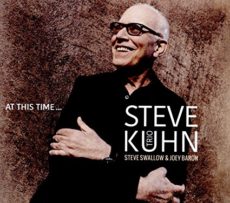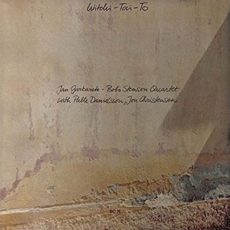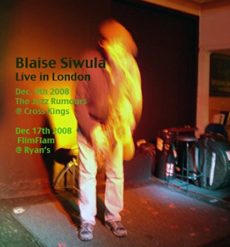
Daily Dose Of Jazz…
Linda Sharrock was born Linda Chambers on April 2, 1947 in Philadelphia, Pennsylvania and began singing in church choirs as a child. Interested in both folk music and jazz, she studied art while in college and became interested in avant-garde music.
She performed with Pharoah Sanders in the mid-1960s and late in 1966 she married Sonny Sharrock and professionally began using the spelling Lynda. She worked with him and Sanders into the early 1970s, as well as with Herbie Mann.
One of her best-known performances is on the 1969 Sonny Sharrock album Black Woman, released on Vortex Records. She toured Istanbul, Turkey in 1973 and recorded with Joe Bonner in 1974. After her divorce in 1978 she returned to using Linda, though she kept his surname.
A move to Vienna, Austria saw Sharrock working with Franz Koglmann, Eric Watson, and Wolfgang Puschnig well into the 1990s. She worked with ensembles such as the Pat Brothers, Red Sun, and AM4 in the 1980s, and with Harry Pepl in 1992.
Suffering a stroke in 2009 which left her partially disabled and aphasic, she briefly withdrew from the scene before returning in 2012. Since then the avant-garde and free jazz vocalist Linda Sharrock has appeared and recorded in France, Austria, the United Kingdom, the Netherlands, Slovenia, with various ensembles under the Linda Sharrock Network label.
Sponsored By
www.whatissuitetabu.com
![]()
#preserving genius
More Posts: vocal

Daily Dose Of Jazz…
Steve Kuhn was born on March 24, 1938 in Brooklyn, New York City and began studying piano at the age of five. He studied under Boston, Massachusetts piano teacher Margaret Chaloff, mother of jazz baritone saxophonist Serge Chaloff. She taught him the Russian style of piano playing and at an early age he began improvising classical music.
As a teenager Steve appeared in jazz clubs in the Boston area with Coleman Hawkins, Vic Dickenson, Chet Baker, and Serge Chaloff. After graduating from Harvard University, he attended the Lenox School of Music where he became associated with Ornette Coleman, Don Cherry, and Gary McFarland. His professors included Bill Evans, George Russell, Gunther Schuller, and the members of the Modern Jazz Quartet. This experience with some of the most forward-thinking innovators of jazz improvisation and composition culminated with his joining trumpeter Kenny Dorham’s group for an extended time and for a brief time in John Coltrane’s quartet at New York’s Jazz Gallery club.
Kuhn has appeared or recorded with Stan Getz, Art Farmer, Oliver Nelson, Gary McFarland, Art Farmer, Joe Henderson, Scott LaFaro, Harvie Swartz, Pete LaRoca, Sheila Jordan, Billy Drummond, David Finck, and Miroslav Vitous. In 1967 he moved to Stockholm, Sweden where he worked with his own trio throughout Europe until 1971. Moving back to New York City he formed a quartet while continuing to play European gigs and appearing at the Newport Jazz Festival.
Known as an avant-garde pianist in his early career, he was associated with bassist Steve Swallow and drummer Pete La Roca during the Sixties that produced several notable recordings. He was part of the quartet on the landmark recording Sound Pieces led by saxophonist, composer, and arranger Oliver Nelson with bassist Ron Carter and drummer Grady Tate. Among other critically acclaimed recordings there was The October Suite composed by Gary McFarland for Kuhn and an ensemble which included strings, woodwinds, and reeds.
For decades he has led all-star trios that have included such players as bassists Ron Carter and David Finck, and with drummers Al Foster, Jack DeJohnette, and Joey Baron. Pianist Steve Kuhn is the composer of the jazz standard The Saga of Harrison Crabfeathers, has recorded several live albums at New York City jazz clubs and continues to lead a trio and compose.
#preserving genius
More Posts: piano

Daily Dose Of Jazz…
Fred Anderson was born on March 22, 1929 in Monroe, Louisiana and learned to play the saxophone by himself when he was a teenager. Moving with his family to Evanston, Illinois in the 1940s he studied music formally at the Roy Knapp Conservatory in Chicago, Illinois and had a private teacher for a short time.
He was one of the founders of the Association for the Advancement of Creative Musicians (AACM) and an important member of the musical collective. In the early 1960s Fred formed his own group and performed his original compositions with drummer Vernon Thomas, bassist Bill Fletcher, and his partner for many years, trumpeter Billy Brimfield.
During this period he recorded several notable avant garde albums as a sideman with saxophonist Joseph Jarman, As If It Were the Seasons and Song For which included one of his composition Little Fox Run. By 1972 he put together the Fred Anderson Sextet, with trombonist George Lewis, reedist Douglas Ewart, bassist Felix Blackman, drummer Hamid Drake and Iqua Colson on vocals. Throughout the Seventies he toured Europe, recorded in Austria, and recorded his first record as leader, Another Place in Germany.
He opened the short-lived performance-workshop space Birdhouse in honor of Charlie Parker, and in 1983 took over ownership of the Velvet Lounge in Chicago, which quickly became a center for the city’s jazz and experimental music scenes. The club expanded and relocated in the summer of 2006. Before that, his eclectic Beehive bar in west Chicago was a draw where musicians from around the world drank beer and played, mostly for each other.
Though remaining active as a performer, Anderson rarely recorded for about a decade beginning in the mid-1980s but by the Nineties he resumed a more active recording schedule, both as a solo artist, and as a collaborator with younger performers. He mentored a host of young musicians not limited to Hamid Drake, Harrison Bankhead, David Boykin, Nicole Mitchell, Justin Dillard, Aaron Getsug, Josh Abrams, Fred Jackson, Jr., George Lewis, Karl E. H. Seigfried, Isaiah Sharkey, and Isaiah Spencer.
Chicago avant-garde tenor saxophonist Fred Anderson, who was rooted in the swing and hard bop idioms but incorporated innovations from free jazz, passed away on June 24, 2010.
Sponsored By

![]()
#preserving genius
More Posts: saxophone

Daily Dose Of Jazz…
Jan Garbarek was born March 4, 1947 in Mysen, Norway and grew up in Oslo, the only child of a former Polish prisoner of war and a Norwegian farmer’s daughter. He began his recording career in the late 1960s featured on recordings by jazz composer George Russell. Initially influenced by Albert Ayler and Peter Brötzmann, by 1973 he left avant-garde jazz, and gained wider recognition working with pianist Keith Jarrett’s European Quartet, recording on six Jarrett albums between 1974 and 1979.
As a composer, he draws from Scandinavian folk melodies and his Ayler influence, as well as being a pioneer of ambient jazz composition, exhibited on his Dis album with guitarist Ralph Towner. Jan has ventured into new-age music, set a collection of Olav H. Hauge poems to music, solo saxophone complemented a full mixed choir and incorporated synthesizers and elements of world music.
Garbarek has recorded more than two-dozen albums as a leader and another 45 to date as a sideman with Karin Krog, Terje Rypdal, George Russell, Art Lande, Ralph Towner, Bill Connors, David Darling, Keith Jarrett, Egberto Gismonti, Charlie Haden, Zakir Hussain, Trilok Gurtu, Manu Katché, Eleni Karaindrou, Kim Kashkashian, Marilyn Mazur, Gary Peacock, L. Shankar, Paul Giger, Giya Kancheli, Miroslav Vitous, Eberhard Weber and Kenny Wheeler
His album Officium, a collaboration with early music vocal performers the Hilliard Ensemble, became one of ECM’s biggest-selling albums of all time. Saxophonist Jan Garbarek, who received a Grammy nomination in 2005 for his album In Praise of Dreams, He is also active in classical and world music and continues to perform, record and tour.
#preserving genius
More Posts: saxophone

Daily Dose Of Jazz…
Blaise Siwula was born in Detroit, Michigan, on February 19, 1950 and grew up in a working/middle-class Black neighborhood. His next-door neighbor practiced saxophone in the afternoon and occasionally allowed him inside to watch him play. He began studying the alto saxophone at the age of 14, playing in the middle-school concert band. But, upon hearing John Coltrane’s Om in 1969, he was compelled to take the tenor saxophone and make it his voice.
He attended college on and off for an extended period from 1968-1980, studying theory and composition at Wayne State University and earning his B.F.A. degree. Siwula’s first personal encounters with jazz musicians came around 1971 with drummer Doc Watson, while both were living in a hotel near the downtown campus of Wayne State. Then the saxophonist got married, moved to San Francisco, California and started playing free improvised music in coffee houses and writing poetry.
Influenced by hearing Art Pepper in San Francisco, as well as Ornette Coleman, Sonny Stitt, Archie Shepp, Pharoah Sanders, Sun Ra, Blue Mitchell, Elvin Jones, and Miles Davis in memorable live performances around the Detroit area in the early ‘1970s. After spending four years in Northern California, Blaise moved back to Detroit, then headed for Europe in 1989, working and traveling as a street musician for three months, then returning to the States and settling in New York City.
Active on the metro New York improvisation scene, he worked with Amica Bunker, the Improvisers Collective, and the Citizens Ontological Music Agenda (COMA) series. During the decade of the 2000s, he concentrated his efforts as a spontaneous composer incorporating traditional musical scoring techniques with visual/graphic and performance-oriented presentations.
Over the course of his career he has played or collaborated with Doug Walker’s Alien Planetscapes, Cecil Taylor’s Ptonagas, William Hooker’s ensembles, Judy Dunaway’s Balloon Trio, Dialing Privileges with Dom Minasi and John Bollinger, Karen Borca, William Parker, Jeff Platz, Adam Lane, Wilber Morris, Vincent Chancey, Theo Jörgensmann, Rashid Bakr, Tatsuya Nakatani,, Jay Rosen, Sarah Weaver, Fala Mariam, Ernesto Rodrigues, Hilliard Greene, Joe McPhee, Ernesto Diaz-Infante, Maria De Alvear, Vattel Cherry, and Jeff Arnal, among others.
Avant-garde alto saxophonist Blaise Siwula also plays the clarinets, flutes, percussion and string instruments and continues to perform and record free jazz and curate.
Sponsored By
www.whatissuitetabu.com
![]()
#preserving genius
More Posts: clarinet,flute,percussion,saxophone,strings




